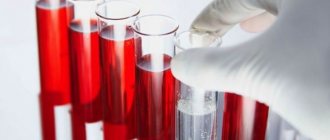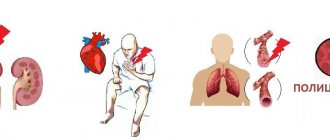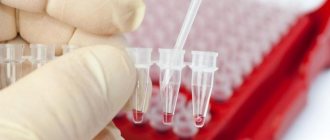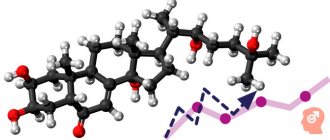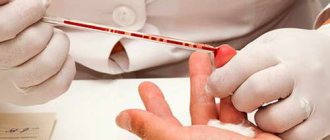Editor: Andriyanov G.Yu., general practitioner, Ph.D. April, 2019.
Synonyms: hematocrit, hematocrit number, hematocrit value, Ht, Hct, Hematocrit.
The hematocrit number is the ratio of the red blood cell volume to the liquid amount of blood (i.e., the ratio of the volume of red blood cells to plasma). The determination of this indicator is included in the mandatory list for determining other indicators in a general blood test (CBC). Hematocrit measurement is not performed separately.
The hematocrit value is used to judge the thickness of the blood and its ability to transport oxygen.
Photo: with a decrease in hematocrit value, the ratio of red blood cells to plasma volume decreases
Indications
The appointment of an OAC, which includes a hematocrit study, is included in the standard patient examination plan and is mandatory:
- when undergoing a medical examination and/or medical examination;
- if any disease is detected or suspected by a clinic doctor;
- in preparation for planned surgery;
- during hospitalization (on the day of admission and on the eve of discharge).
Calculation of the hematocrit number is required for certain indications;
- blood clotting disorder;
- dehydration (dehydration);
- assessment of the degree of anemia (anemia), polycythemia (increase in blood cells);
- bleeding.
Hematocrit norms
Hematocrit values depend on age, as well as gender (in adults).
Important! Standards may vary depending on the reagents and equipment used in each particular laboratory.
That is why, when interpreting the results, it is necessary to use the standards adopted in the laboratory where the analysis was carried out. You also need to pay attention to the units of measurement. Generalized standards adopted in Russia are given in the table:
Western medical literature provides more general reference values:
- Men - 0.40-0.54 / 40-54%
- Women - 0.36-0.46 / 36-46%
- Newborns - 0.53-0.69 / 53-69%
Factors influencing the result:
Hematocrit increases against the background
- stress,
- taking corticosteroid drugs and diuretics,
- traumatic shock accompanied by intense pain.
A decrease in hematocrit is facilitated by:
- prolonged immobility;
- taking blood thinners (disaggregants, anticoagulants);
- high fluid intake;
- chronic alcoholism.
Important! The interpretation of the results is always carried out comprehensively. It is impossible to make an accurate diagnosis based on only one analysis.
Norms
The normal hematocrit level depends on the age and gender of the person. For a mature woman it is 37-50%, for a man 34-45%. For newborns, this figure may be higher and ranges from 35 to 65%. As people grow older, the hematocrit decreases, reaching minimal levels in the elderly. This is the result of decreased bone marrow activity and decreased production of blood cellular elements.
A decrease in normal hematocrit in women is associated with regular blood loss during menstruation. High values in children are a manifestation of active processes in the development of red bone marrow and other hematopoietic organs.
It is important to consider that after massive blood losses and blood transfusions, determining the hematocrit level will give results with a large error. To reliably assess this indicator in such cases, it is necessary to wait a certain time.
It may take up to 3 months for complete physiological restoration of red blood cell levels to normal levels. This period is the life cycle of red blood cells, during which the cellular composition of the blood is renewed.
Reasons for decreased hematocrit
Gestational period. Starting from the second trimester, the volume of circulating blood increases, but the number of red blood cells does not change.
Overhydration. Intravenous massive infusions lead to an increase in the volume of circulating blood, that is, to dilution of the blood, while the number of red blood cells remains the same.
Anemia of various origins. The lack of red blood cells naturally affects hematocrit values.
Intensive destruction of red blood cells. Occurs in the presence of hemolytic anemia of hereditary or acquired origin, in case of poisoning with hemolytic toxins (salts of heavy metals, consumption of toadstool) or serious infectious diseases (malaria, typhoid fever).
Blood loss (internal or external bleeding). Replenishment of circulating blood volume can be done quickly with crystalline or colloidal solutions. Restoration of lost red blood cells occurs only after a certain time or through blood transfusion.
Hyperproteinemia (increased total protein in the blood). This condition is observed in myeloma, lymphogranulomatosis, paraprotienemic hematoblastoses, diarrhea and vomiting. Excess protein in the blood draws fluids from the body into the bloodstream, increasing the volume of circulating blood while maintaining the same number of red blood cells.
A disorder of the formation of new red blood cells in the bone marrow. May be caused by blood diseases (anemia, leukemia), taking cytostatics and antitumor drugs, and renal paresis.
Tactics depending on the degree of reduction in the indicator:
- A decrease in hematocrit in the range of 35-30% requires outpatient observation by a doctor and changes in diet (increase consumption of meat, leafy greens, liver).
- When the hematocrit value decreases to 29-24%, iron supplements, B vitamins and folic acid are prescribed.
- If the rate drops to 13% or less, the condition is considered extremely serious and requires emergency hospitalization.
When the hematocrit decreases and anemia is detected in people over 65 years of age, the examination should be more thorough, since anemia in old age often accompanies serious diseases, for example, renal failure, hypo- or hyperthyroidism.
Increased hematocrit
Many people are interested in the question of when the hematocrit is increased, what does it mean. First of all, the indicator increases with the accelerated production of red blood cells by the bone marrow. An increase in the size of red blood cells can also lead to deviations above normal. This occurs in various pathological conditions, namely:
- Primary erythrocytosis, which occurs against the background of overactive production of red blood cells, most often indicates tumor processes in the bone marrow.
- Secondary erythrocytosis is associated with pathologies of the respiratory and cardiovascular systems, in particular, it develops with respiratory failure or heart disease.
A decrease in plasma volume, and, consequently, an increase in hematocrit may indicate the development of peritonitis, leukemia or kidney pathologies. This also happens with extensive burns. The cause of dehydration is often uncompensated diabetes mellitus.
Erythrocytosis at the initial stage, when the hematocrit is slightly increased, is asymptomatic. In most cases, abnormalities are discovered accidentally during a routine medical examination. But with a significant increase, it is discovered by chance, when taking a blood test for other reasons. Only with a significant increase in hematocrit do warning signs arise:
- Pain in joints and muscles.
- Shortness of breath, weakness and increased sweating.
- Dizziness.
- Increased pressure.
Since symptoms are not specific, if they appear, you should undergo a full examination in order to make a correct diagnosis. Treatment can only be successful if the cause of the increase in the number of red blood cells in the total blood volume is established.
Reasons for increasing hematocrit
Dehydration (dehydration). Loss of fluid due to repeated vomiting and/or diarrhea, sunstroke, burn disease, pathology of the digestive tract, intestinal obstruction, hyperhidrosis (excessive sweating), peritonitis leads to blood thickening due to an unchanged number of red blood cells.
Hypoxia. People suffering from diabetes, smokers, people located high in the mountains or in unventilated areas experience a lack of oxygen, which leads to the release of red blood cells into the bloodstream.
Cardiovascular pathology. Heart defects, coronary disease, and cardiovascular failure are accompanied by a lack of oxygen in the blood.
Bronchopulmonary pathology. Chronic hypoxia leads to: bronchial asthma, emphysema, obstructive bronchitis and other pulmonary diseases.
Neoplasms in the kidneys. Any kidney tumor provokes increased production of erythropoietin, which increases the formation of red blood cells.
Erythrocytosis. The pathology is characterized by increased production of red cells (true erythrocytosis) or redistribution of formed blood elements in some diseases (redistribution).
Erythremia. Refers to true erythrocytosis, synonymous with Vaquez-Osler disease. It is one of the variants of chronic leukemia.
Leukemia. Accompanied by an increase in white blood cells and a decrease in its liquid part.
Hematocrit increased
An increase in the level of red blood cells detected in a hematocrit analysis may indicate various pathological conditions. The most common:
- Primary erythrocytosis. It occurs as a result of overactive production of red blood cells, including immature forms. May indicate the development of tumors in the bone marrow.
- Secondary erythrocytosis. Develops as a consequence of pathologies of the respiratory and cardiovascular systems (heart defects, respiratory failure).
- Reduced plasma volume. May indicate the development of peritonitis, leukemia, kidney disease. Often occurs with extensive burns, when blood plasma sweats through the damaged dermis.
- Dehydration. Observed in uncompensated diabetes mellitus, it can result from diarrhea, vomiting, excessive sweating and lack of fluid in the diet.
Erythrocytosis can develop in heavy smokers, especially if smoking has led to secondary damage to the respiratory system and heart. In this case, the body turns on mechanisms to compensate for insufficient oxygenation due to a significant increase in the number of red cells.
An increase in hematocrit is not always a consequence of disease. An increase in the number of red blood cells is considered normal for residents of mountainous areas and professional climbers. When exposed to high altitude conditions for a sufficiently long time, the body compensates for the lack of oxygen and atmospheric pressure by increasing the production of red blood cells.
Erythrocytosis is often asymptomatic and is discovered by chance during a blood test for other reasons. Only with a significant increase in hematocrit are the following observed:
- Pain in joints, muscles.
- Dyspnea.
- High blood pressure.
- Ringing in the ears and dizziness.
- Increased sweating, sleep disturbances.
These symptoms are not specific, so if such ailments occur, you should consult a doctor for further diagnosis.
To restore the physiological level of hematocrit, it is necessary to find out the reason that led to an increase in the amount of blood cells and eliminate it. For example, if erythrocytosis was caused by dehydration (lack of water in the body - dehydration), it is enough to restore the normal amount of fluid to normalize this indicator.
There is no need to self-medicate; only a specialist can accurately determine the cause of the increase in hematocrit and prescribe the correct diagnosis and treatment. Therefore, if there are any changes in the blood test, you should consult a specialist and strictly follow the recommendations received.
Preparation
Donating blood for a general analysis does not require special preparation, but to identify an adequate clinical picture of the formed elements and hematocrit, it is recommended to adhere to the following rules:
- Blood donation is performed on an empty stomach;
- stopping smoking in the morning on the day of the test (blood is donated in the morning);
- refusal of physical activity the day before and on the day of delivery of the biomaterial;
- prohibition of taking anticoagulants, antiplatelet agents and other drugs that affect the blood coagulation system 3 days before the study;
- abstaining (if possible) from stress and emotional experiences on the eve of the study;
- refusal to carry out diagnostic procedures (x-ray, ultrasound and other studies) the day before donating blood.
Sources:
- A.A. Kishkun, Doctor of Medical Sciences, Prof. Guide to laboratory diagnostic methods, - GEOTAR-Media, 2007.
- Mandy Flannery O'Leary, MD, MPH, FCAP. Hematocrit. — Laboratory Medicine, Medscape, 2014.
- Andrew S Artz, MD, MS. Anemia in Elderly Persons. - Hematology, Medscape, 2015.

